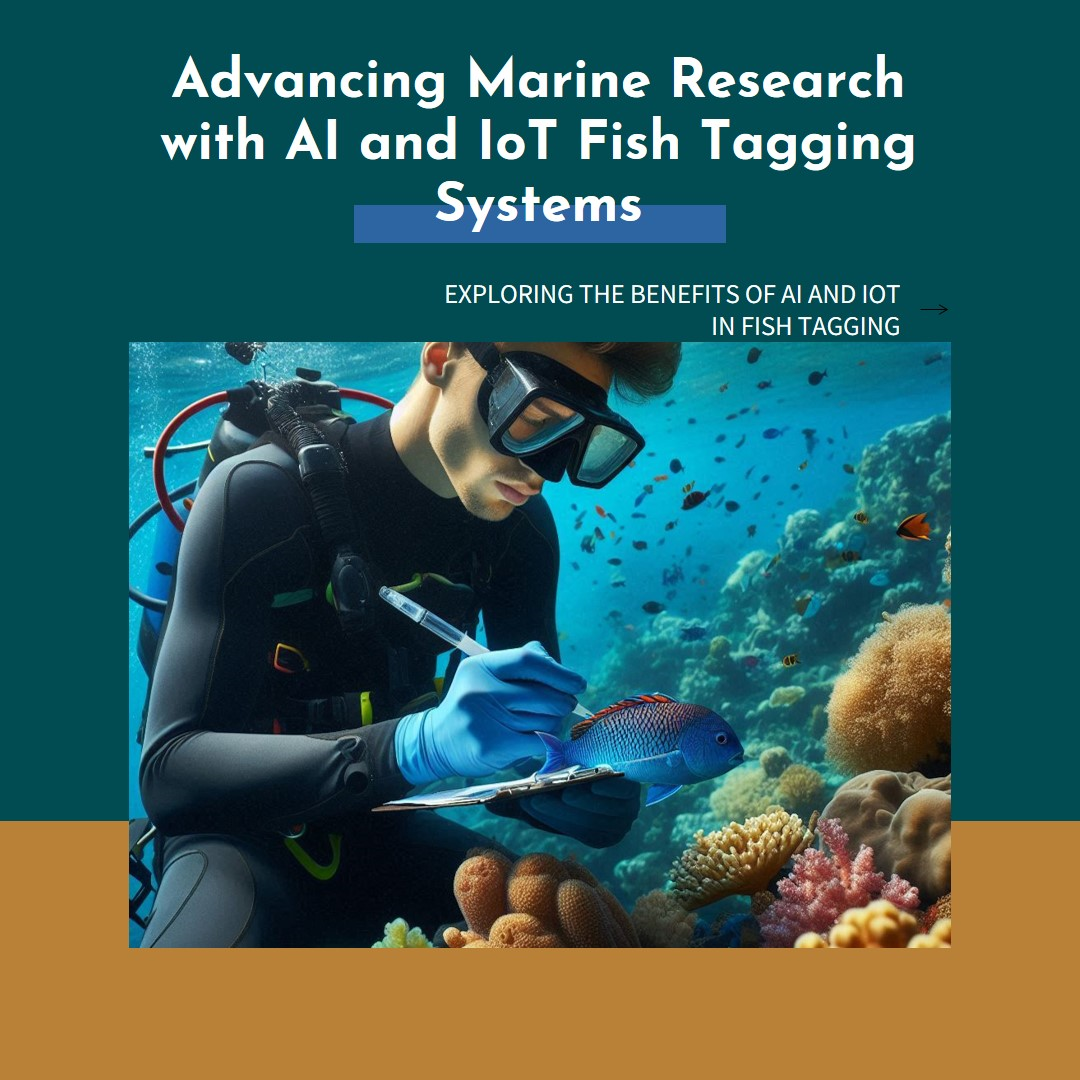Marine ecosystems are critical to the health of our planet, yet they remain one of the least explored environments. Understanding marine life behavior, migration patterns, and population dynamics is vital for effective conservation efforts. Fish tag systems have become an essential tool for researchers, and the integration of Artificial Intelligence (AI) and the Internet of Things (IoT) into these systems is revolutionizing marine research.
In this article, we’ll explore how AI and IoT in fish tagging system benefit marine research, the key advancements driving these technologies, and why they are shaping the future of marine conservation.
What Are Fish Tagging System?
Fish tagging system involve attaching electronic tags to fish and other marine species to track their movements, behavior, and environmental interactions. These systems are crucial in gathering long-term data on species’ lifecycles, habitat use, and migration routes.
Tags can vary in design, ranging from simple physical markers to advanced acoustic, PIT (Passive Integrated Transponder), or satellite tags. Over time, tagging technology has evolved, and now, the integration of AI and IoT is bringing unprecedented capabilities to this field.
The Role of IoT in Fish Tagging System
The Internet of Things (IoT) refers to the network of interconnected devices that collect and exchange data. In marine research, IoT devices have transformed fish tagging system by enabling seamless, real-time data collection and transmission.
Traditionally, fish tagging involved manually retrieving data from tags, often requiring close proximity to tagged animals or equipment. With IoT integration, data is transmitted wirelessly via satellite or cellular networks to researchers onshore. This means that marine scientists can now monitor tagged fish in real-time, even when they are hundreds of miles away from the marine environments they study.
AI’s Contribution to Analyzing Collected Data
Once collected, the immense volume of data generated by IoT-enabled tagging systems would be overwhelming without Artificial Intelligence (AI). AI algorithms can analyze this data to recognize patterns, predict behaviors, and even detect anomalies in migration routes or population structures.
For example, AI can assess the impact of environmental changes, such as rising sea temperatures, on specific species’ migration patterns. The technology can also be used to track the spread of invasive species, which are often difficult to monitor manually.
Moreover, AI algorithms can process data faster and more accurately than traditional methods. By recognizing patterns that may be invisible to the human eye, AI can provide insights into fish populations’ health, reproductive cycles, and ecosystem dynamics.
How the Integration of AI and IoT Benefits Marine Research
1. Improved Data Accuracy and Availability
IoT-enabled fish tagging system significantly improve the accuracy of data collection. Previously, researchers relied on sporadic, manual data retrieval, which often led to gaps in information. IoT allows for continuous data streaming, providing a more complete picture of marine species’ behaviors.
By leveraging AI, the quality of data interpretation improves further. Machine learning algorithms can sift through terabytes of data in seconds, finding connections that may otherwise go unnoticed.
2. Enhanced Real-Time Monitoring
Real-time monitoring is another major benefit of integrating AI and IoT into fish tag systems. Researchers no longer have to wait for weeks or months to access data. Instead, they can monitor tagged fish instantly and make timely decisions based on the latest information.
For instance, if a tagged fish enters a region known for illegal fishing or environmental dangers, AI-powered systems can send alerts to conservationists or authorities. This real-time insight helps protect vulnerable species from human threats and natural hazards.
3. Deeper Insights into Fish Behavior
Through the combination of AI and IoT, fish tag systems are offering deeper insights into fish behavior than ever before. Behavioral patterns—such as feeding times, breeding periods, and predator-prey interactions—can be recorded and analyzed continuously.
For example, Voda IQ is at the forefront of integrating AI-powered solutions into fish tag systems, helping marine researchers gather critical insights into the behavioral dynamics of fish populations. By using machine learning, the system can learn over time and improve the accuracy of its predictions, enhancing the understanding of fish behavior in various ecosystems.
4. Conservation Efforts
The ongoing biodiversity crisis has led to a growing need for sustainable conservation practices. The data collected by AI-IoT-enabled fish tag systems can directly impact policy and conservation efforts. Researchers can now track endangered species’ populations in real-time, helping ensure that conservation strategies are working effectively.
Governments and NGOs use this data to establish Marine Protected Areas (MPAs) and track the recovery of overfished species. IoT-powered systems, when paired with AI analysis, allow for faster and more accurate responses to changes in population dynamics, helping prevent species from slipping toward extinction.
5. Cost-Efficiency and Scalability
While the initial setup for IoT and AI-powered fish tag systems can be costly, the long-term savings in time and resources are considerable. IoT reduces the need for frequent expeditions to retrieve data, and AI reduces the need for manual data processing.
Moreover, these systems are scalable. Whether tracking a single species or entire ecosystems, IoT and AI integration can handle the load, making it an ideal solution for large-scale research projects.
6. Global Collaboration and Open-Source Data
Another advantage of AI-IoT systems is their ability to foster global collaboration. Data collected from these systems can be shared with research institutions and conservation organizations around the world, creating a shared knowledge base.
Many IoT platforms, like Voda IQ, make their data open-source, allowing marine biologists, conservationists, and even citizen scientists to access and analyze it. This collaborative approach accelerates research and enables more comprehensive global conservation strategies.
Real-World Examples of AI and IoT in Marine Research
Several research projects are already benefiting from the integration of AI and IoT in fish tagging system:
- Project Ocean Tagging Initiative: This project involves tracking large pelagic fish, such as tuna and sharks, using satellite tags that transmit data to IoT platforms. AI analyzes migration patterns and environmental data to understand how climate change impacts these species.
- NOAA’s Acoustic Telemetry Network: The National Oceanic and Atmospheric Administration (NOAA) uses IoT-powered acoustic tags to track fish movements along the U.S. East Coast. AI processes the acoustic data, revealing new insights into habitat use and spawning behavior.
- Voda IQ’s Marine Tagging Program: Voda IQ provides advanced IoT solutions for marine research. Its fish tag systems utilize AI to help researchers monitor fish populations and migration patterns in real-time, contributing to global efforts in marine conservation.
The Future of AI and IoT in Marine Research
As AI and IoT technologies continue to evolve, the potential for their application in marine research will grow. Future developments could include:
- Smaller, more efficient IoT tags: Reducing the size of tags could minimize their impact on fish behavior and increase their adoption in smaller species.
- AI-driven predictive models: Enhanced AI algorithms could predict marine species’ behavior with even greater accuracy, allowing for better conservation strategies.
- Improved integration with satellite and oceanographic data: By combining IoT and AI with oceanographic data, researchers can gain a holistic view of marine ecosystems, leading to more comprehensive research outcomes.
FAQs
1. How do IoT-enabled fish tagging system work?
IoT-enabled fish tagging system use electronic tags that transmit data wirelessly to a network of sensors or satellites. The data is then sent to cloud-based platforms for real-time analysis.
2. What is the role of AI in fish tag systems?
AI processes the large volumes of data generated by fish tag systems. It identifies patterns, predicts behavior, and helps researchers gain deeper insights into marine species and their ecosystems.
3. How does Voda IQ contribute to marine research?
Voda IQ provides IoT-based tagging systems that use AI to track fish movements and behavior, giving researchers critical insights for conservation efforts.
4. What are the main benefits of integrating AI and IoT in fish tag system?
The main benefits include real-time monitoring, improved data accuracy, enhanced insights into fish behavior, and cost-efficiency in marine research projects.
5. How is AI changing marine conservation?
AI enables faster and more accurate data analysis, helping conservationists develop effective strategies to protect endangered species and their habitats.
Conclusion
The integration of AI and IoT in fish tagging system represents a game-changing advancement for marine research. By enabling real-time data collection, analysis, and deeper insights into marine life, these technologies are helping scientists make more informed decisions about conservation and species protection. As the technology continues to improve, its potential to revolutionize our understanding of the oceans will only grow.
Are you ready to explore the future of marine research with AI and IoT technology?
Also know about Can PIT Tags Help in Studying Fish Diseases and Treatments? | Comprehensive Guide




